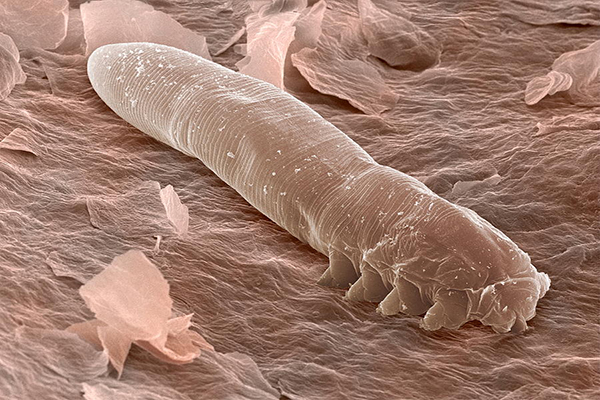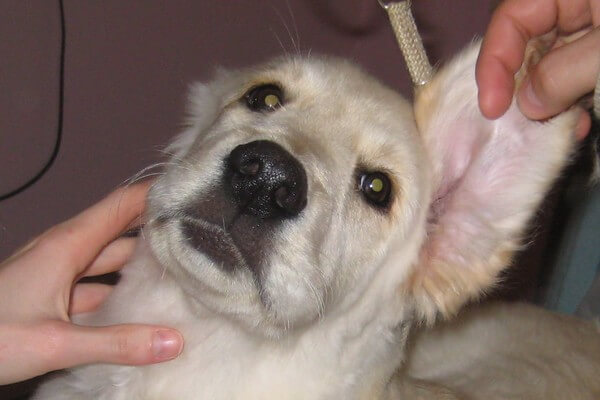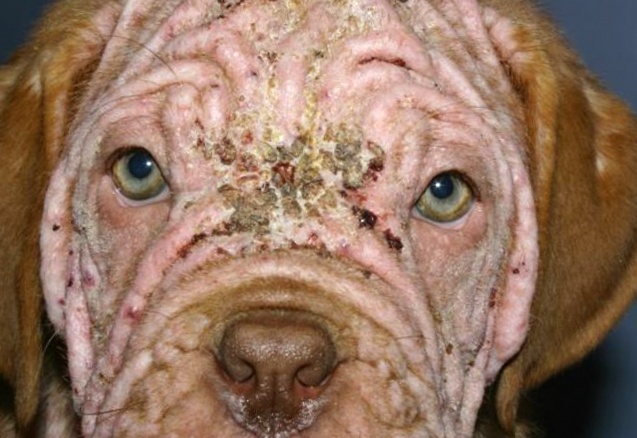However, it is quite difficult to place accurate veterinarians - the external signs of the sternum are often confused with the clinical symptoms of ordinary skin dermatitis, which are caused by other causes and have a different etiology. With a routine examination of the dog, it is possible to diagnose demodicosis only in the presence of a characteristic "demodectic" odor, which is absent in dermatitis.
To diagnose the same demodicosis in a dog can be quite simple - it is necessary to conduct microscopy of pustules from the lesion focus. Under the microscope, the contents of the foci quite clearly show the presence of the tick. In this case, the material for investigation should be taken from the deep layers of the skin, obtained by scraping. You can also conduct a microscopic analysis of the hair, examining the affected hair follicles from the lesion, or pustules themselves (pustules), scraping them off the skin.
Treatment of demodectic
Treatment of subcutaneous mites (stamina) in dogs is a neutralization of the pathogen, achieved by suppressing the life of the mite Demodex canis, as well as the elimination of predisposing conditions for demodicosis - strengthening immunity, treating skin atony and balancing hormonal abnormalities.
Subcutaneously to the dog biological preparations are introduced, the most popular of which today is considered to be "Ivomek", containing in its composition an active substance - ivermectin, which kills a mite. However, the widespread use of this drug has led to the fact that today the mite does not always respond to its use and, probably, has developed immunity.
External processing The skin of the animal is also effective, as it kills the mite during its migration through the surface of the skin and on the hair.
Doctors today have refused the oral administration of chlorophos, which is too toxic and has a dangerous effect on internal organs. Chlorophos contains organophosphorous substances, and it is better to use it for external treatment of skin and wool. In addition, sulfur-containing liniments, as well as cyclone and amitraz are well suited for external processing.
Elimination of pathogenesis
In order to improve protective functions of the dog's body and eliminate the factors that have to develop demodicosis, veterinarians recommend the prevention and treatment of skin atony. The treatment improves hair growth and strengthens follicles of hair bulbs, and therefore complicates the tick condition for penetration under the skin of the dog. To do this, dogs are recommended to give sulfur and rub in the skin the sulfur-containing liniments in the places of alopecia.
In the presence of hypothyroidism (suppressed skin immunity), a few drops of a 5% iodine solution can also be added to the food. Iodine is also required when the corticosteroid is high in the dog's body. It is used concomitantly with the addition of chladitan - an inhibitor of the adrenal glands.
It often occurs, this is a serious disease called demodecosis. Saturating with the blood of an animal, the parasite increases and you can notice it with the naked eye.
In the early stages of the disease, localization of insects is difficult to detect, as a rule, they affect the head, ears, neck and limbs of the pet. The weakened and young animals, whose unpleasant symptoms of the disease develop rapidly, are most susceptible to attack by ticks. How to recognize the disease at an early stage and successfully cure the animal?
Subcutaneous mite in dogs - symptoms
- restless behavior;
- irritability;
- the formation of red spots and inflammations on the skin;
- partial loss of wool;
- the appearance of suppuration.
The scaly form of the disease is easily recognized by visible peeling on the surface of the skin. In addition, this phenomenon is accompanied by additional inflammation and bacterial infections.
A sign of pustular formations under the skin of a dog are seals, whose diameter does not exceed 0.5 cm. Of these, purulent discharge and blood form crusts.
The generalized form includes a set of the above options. Extensive affection with the tick leads to a thin skin and diseases of the internal organs.
Demodectic pododermatitis is a form of a disease characterized by the defeat of the animal's forelimbs. The skin on the affected area thickens, covered with otrigious scales. In advanced cases, a bacterial infection develops that causes general sepsis and malnutrition.
Feeding on biological material near the sebaceous gland or at the bottom of the hair follicle, the subcutaneous tick damages the epithelial layer.
In the veterinary clinic, a specialist will take an animal analysis - scraping of the skin, which will be treated with a microscope. Photos of subcutaneous mites can be seen on the sites devoted to diseases of pets.
Scabies mite under the skin of the dog is intensively nourished and multiplies, so that the animal experiences pain. A symptom of the disease at an early stage is traces of irritation, scratches and scratches on the animal's body, shown in the photo in veterinary clinics.
It is impossible to make an accurate diagnosis without laboratory tests. But the neglected disease is characterized by such symptoms as attempts to rip off inflamed skin areas, the appearance of extensive bald spots with bleeding edges, an increase in lymph nodes and the swelling of the paw pads.
In this case, you should contact the veterinary clinic immediately. Independent treatment, as a rule, does not give a positive result and brings short-term relief. The specialist will carefully examine the animal and prescribe the necessary procedures and preparations.
Subcutaneous mite in dogs - treatment
An important part of recovery is the maintenance of animal hygiene. In order for the annoying symptoms to disappear quickly, a number of activities should be carried out:
- replacement of all dog accessories;
- thorough cleaning of the room;
- regular processing of toys and pet dishes.
The veterinarian will be able to recognize the subcutaneous tick in the dog, the expert also analyzes the symptoms and treatment.
The subcutaneous tick in dogs is successfully treated with the help of intramuscular injections of the drug, which includes cells of a weakened pathogen. Only the doctor can calculate the correct dosage.
Local therapy of affected skin includes bathing and treatment with acaricidal ointments. These remedies effectively kill ticks without harming the health of the dog.
It is important not to lick the treated areas, so the pet should wear a special collar. In addition, to cleanse the skin and remove painful symptoms will help tar emulsion, and best to smear the abscess with sintomycin ointment to relieve inflammation and eliminate unpleasant odor.
Forecast for different forms of the disease
Dogs under the age of 1 year are subject to localized demodicosis. They are ill as a result of a stressful situation or a decrease in immunity. The symptom of the disease is a rare coat around the eyes, mouth and front paws. In this case, most animals are successfully cured and restored.
Generalized (mixed) demodicosis begins with local spots and redness, then an acute phase of the disease occurs. Veterinarians believe that the younger the animal, the higher the probability of victory over the disease.
Adults and recover more slowly. Often the treatment stretches for 2 or more months, if there are other diseases.
It is worth noting that it is most difficult to get rid of the mixed form of demodicosis, since the complete extermination of the colony of mites takes a long time.
Drugs kill adult individuals, and after stopping medication and cleaning procedures, insect larvae grow and begin to multiply. Therefore, veterinarians stop the necessary treatment only after receiving 3 or more tests in which the pathogens shown in the photo close-up are not found.
The master's task is not only to follow the appointments of the veterinarian, but also to fix the dog during the therapeutic bath. The immobile state increases the penetration of active substances and accelerates recovery. Anxious animals should provide peace and exclude contact with other pets.
Subcutaneous mite in dogs is completely cured with strengthening immunity and carrying out all cleaning procedures. Photos before and after treatment can be seen on the Internet.
Prophylaxis of demodecosis in dogs
Knowing the danger of this disease, it is easy to understand the ways of preventing the disease. First of all, you should save the pet from communicating with homeless animals, as well as unhealthy individuals.
Be attentive to the care of the dog, bathe and brush it in a timely manner. Do not allow her to study abandoned premises and suspicious places.
It is important to know that taking corticosteroid hormones leads to suppression of immunity, weakening of the body's protective functions. This should be remembered for the owners of young pets.
Subcutaneous tick in dogs also passes from mother to puppies during childbirth and rearing offspring, so pregnant animals must necessarily undergo a survey with a veterinarian.
Some owners are trying to eliminate the subcutaneous mite itself in dogs. Treatment with folk methods is not effective and leads to sad consequences.
photo from the site: zooclub.ru
Abnormal growth of the causative agent of the sternum leads to extensive damage to the skin, causes a strong allergic reaction and affects the work of internal organs in animals with low immunity.
How to cure a dog from a subcutaneous mite and is it contagious with demadocosis in dogs? It is known that in humans, cattle, cats, cases of infection are rare. The only way to save your pet from the torment that Demodex canis gives him is to call the doctor in time. Measures taken at home and involving the use of a variety of folk remedies will not produce the expected effect. But about everything in order - first we will talk about the features of the onset of the disease and only after we give instructions on the destruction of its pathogen.
Demodex mite: what is known about it
Throughout his life the causative agent of demadecosis takes different forms, moving from one to another:
- First, this spindle-shaped egg is the first stage of development.
- After the eggs, six-legged mite larvae are born.
- Then they get another pair of legs.
- The last stage - the transformation into adult individuals.
In the photo you can see what a hypodermic tick looks like, which causes demodicosis in dogs, close-up.

photo from site: 1litso.ru
Focal form of the disease is most often manifested in young animals (the age in which they become infected most often - from 3 to 12 months). The first signs are noted during puberty and tooth changes. In 90% of cases, the activity of Demodex canis remains unnoticed - the sternum passes spontaneously. But the remaining 10% of the focal form is transferred to the generalized form. The reasons for this deterioration are inherited immunodeficiency, general weakening of the body.
Symptoms of hypodermic mites in dogs: demadectic symptoms and home treatment (photo)
The disease occurs in three forms:
- Scaly
It is considered the easiest, it is with her that spontaneous recovery of the animal is possible. During the examination, the veterinarian notes the presence of affected areas mainly on the head (on the forehead, lips, brow ridges), as well as on the pet's paws. Characteristic of hair loss, the appearance of bald patches, the formation of scales on the skin, local redness and itching. When palpation, there is roughness, the presence of small nodules. The wool surrounding the demodic foci is weak and brittle. In the absence of drug treatment at a later stage, the skin on the affected areas becomes gray, reddened spots appear that indicate inflammation.

photo from the site: VseProSobak.ru
- Pustular
- Generalized
It carries the signs of both forms. In addition to the presence of extensive affected areas, allotriophagy can develop, the oppressed state (lethargy, refusal to eat, constant sleep, decrease in muscle tone) is clearly manifested. Lesions are found not only from the outside, but also inside - demodekoznye foci are found in the lymph nodes, on the walls of the organs (liver, guts), in tissues.
Than and how to treat a subcutaneous mite in a dog? It is important to remember that the first step is to go to the doctor. Do not allow the licking and gnawing of the affected areas - thus the animal can infect the wound, resulting in complications (appearance of the eczema, atopic dermatitis) and prolonged therapy.
Above we told how demodicosis manifests, but how is the subcutaneous tick transmitted to dogs?
Sources of infection
They are not, because the only reason for the formation of bald patches, itching and inflamed skin is only a weakening of immunity. If everything is all right with him, your dog will not get sick. The best protection in this case is the strong health of your animal.

photo from the site: myfreinds-dogs.ru
Normally, your pet's immune system can withstand the increased growth of Demodex canis. If it can not control the number of ticks, their reproduction leads to the development of the disease.
Is demodicosis contagious in dogs? No, it is not transferred from one animal to another or from pet to man. If your pet is healthy, you can avoid going to the doctors - the indicators will be normal. But weakening the defenses of the body will cause the development of the sternum.
Provoke a decrease in immunity can:
- diseases (oncology, hormonal disorders);
- medicines that exert an inhibitory effect on the animal's organism (corticosteroids, chemotherapy, etc.).
How to identify a subcutaneous mite and treat demodicosis in dogs?
External manifestations are as follows:
- thickening of the skin;
- presence of dark-red spots;
- peeling;
- itching - the animal always combs the affected areas;
- loss of hair;
- changing the structure of the hair (becomes brittle, short, loses its shine);
- exfoliating scales of the epidermis resemble dandruff;
- wool fades, seems tousled.
The recovering animal can be distinguished from the patient by less peeling, resuming hair growth, improving their structure, reducing inflammation.
Symptoms of subcutaneous mites in a dog can be seen in the photo to the article, the treatment should be prescribed by a doctor. Self-diagnosis based on pictures from the Internet can lead to disappointing consequences - up to the death of the animal.
What can be confused with demodicosis?
It is necessary to distinguish the disease caused by the mite Demodex canis, from others - no less serious and requiring timely treatment to a specialist:
- Otdetectosis
We already wrote about him in one of the. Its pathogens (Otodectes cynotis) affect only the ears - not only the ear itself, but also the auditory canal. If the dog shakes his head and desperately itches, check the localization of irritation before buying drugs for demodectic.

photo from the site: Dogway.ru
- Sarcoptic disease
It is caused by mites Sarcoptosis canum. They lay eggs under the epidermal layers and make passages there. The affected area is the head. The symptoms are similar to the symptoms of the disease, the development of which provokes the growth of Demodex canis - the formation of nodules with liquid contents, itching, gluing of wool, the presence of dandruff. The correct diagnosis can be made only as a result of the detection of the pathogen in the scrapings of the pet's skin.
- Notoedrosis
Acarias is not only a domestic animal, but a human being. Characterized by irritation, inflammation, the appearance of papules and vesicles. Called arthropod Notoedres cati. Mostly young cats and rodents are ill. What if you think the dog has hypodermic ticks? Call the doctor and find out who will have to fight. Otherwise, the treatment will not bring the desired effect.
- Dermatophytosis
It is also called ringworm, and it is found not only in cats. Characteristic signs - a strong inflammation, itching, scaling of the skin, hair loss at the site of the lesion. The disease can be transmitted from the animal to man. The causative agents are fungal spores of Trichophiton and Microsporum.
- Alimentary dystrophy
Occurs as a result of unbalanced, rare and meager nutrition. One of the main symptoms of the pathological condition is the formation of bald patches (molting does not stop for a long time). At the same time, the animal does not itch, there are no irritated areas of the skin, suppuration and crusts.
- Allergic reactions
They appear suddenly - in the form of rashes on the skin. The pet's body itchs, the affected areas can get wet, but hair loss is not observed. Most often, an allergy occurs with a sharp change in food (for example, the transition from natural nutrition to preserves, etc.), treatment (when the body is exposed to stimulant drugs).
- Infections
For some of them (such as pasteurellosis, pseudorabies), a serious lesion of the skin is possible, but it is noted not as an initial sign of the disease, but as an additional sign. For such pathological conditions, not only rashes and exhaustion are characteristic, but also an increase in body temperature, a disruption in the functioning of internal organs. Pathogens are bacteria or viruses.
How to determine what caused malaise?

photo from the site: parazitovnetu.ru
For this purpose, a laboratory diagnosis of skin scraping taken from affected areas is carried out. Methods used by veterinarians are divided into two groups:
- Mortal
These include adding a solution of potassium or caustic soda to the sample, as well as the method of Extraction (heating the epidermis in a solution of caustic potassium, and then placing them in sodium sulfate and microscopic examination).
- Vital
They are used to search for live ticks. The following methods are distinguished: Poselkovoy (combining scrapes with kerosene), mixing of skin particles with warm water, heating the analysis to 35-45 degrees.
What is demodecosis in dogs, how to cure it and is there a universal medicine for subcutaneous mites? We answered the first question. Symptoms of this disease can be confused with the symptoms of similar pathological conditions, so that only the veterinarian should determine the causative agent and prescribe medications. Do not expect that you will write out one remedy that will instantly save the dog from suffering. Complex therapy is necessary. More details about it we will discuss further.
Experts believe that the most sparing medicines can be prescribed only when the local form of the disease manifests itself. If it is pustular or generalized, the effect on the body will be more aggressive.
In most cases ointments and special shampoos are used to treat animals and treat hair mite (demodectic) in dogs according to a certain pattern at home. Throughout the course, it is important not to stop observing the condition of the pet - any deterioration should be the reason for contacting the vet. Surveys are conducted until a negative test result is obtained.
What can be prescribed when serious forms of the disease are detected?
In this case, treatment will be directed at suppressing developing secondary infections and killing ticks. Most often doctors prescribe:
- Immunostimulants (Immunofan, Ribotan, Fosprenil) - they help restore the defenses of the body. Recall, it is the decrease in immunity leads to the active reproduction of Demodex canis. If the first signs of the disease occur in young animals, autohemotherapy may be used.
- With a mild form - amitraz or yurodeks. These drugs must be treated affected areas once every 7 days. To facilitate the procedure, you need to cut off the hair surrounding the demodectic focus.
- LIV-52 or karsil - is prescribed to support the liver.
- If there are complications (bacterial infection) - cephalexin or other antibiotics.

photo from the site: VashiPitomcy.ru
- As a means of systemic therapy, Syflee is recommended (2 times a week, the course is half a year).
- Locally - vetabiol. This ointment relieves inflammation, promotes the growth of new hair on bare skin areas.
If a dog has found the symptoms of generalized demodicosis, there can be no question of any treatment of a subcutaneous mite with folk remedies or sparing ointments - only active complex therapy. The minimum rate is 1 month. After its termination, a second examination of the scraping is carried out. If the disease continues, you need to change the drugs to avoid getting used to the active substances that make up their composition.
How to cure a dog from a hypodermic tick, remove Demodex canis from a pet and get rid of this problem forever? Follow the advice of a doctor, do not use unknown or doubtful means, without consulting a specialist, remember that setting the right diagnosis is the first and main step on the way to destroying the pathogen. As preventive measures, treatment of the premises with special preparations (Arrivo, Amitrazine) is welcomed.
Do not forget: the presence of a Demodex mite without severe symptoms is not a reason for therapy. Any intervention in the body can cause the development of resistance to the medicines used and the development of a generalized form.
Subcutaneous mites (another name - demodexes) is for every dog, but they do not always show themselves. What triggers the development of the disease? What are the signs and how to cure a subcutaneous mite in a dog? More on this in the material below.
The disease occurs in two forms:
- scaly (another name - squamous);
- pustular (another name - pyodemodecosis) - may be a consequence of scaly form or an independent disease
Attention! The prevalence of the disease can be localized (local) and generalized (general).
Symptoms of demodicosis in dogs are manifested in different ways depending on the type of disease:
Scaled demodecosis - The easiest form. On the body of the dog (usually on the muzzle and paws) appear rounded bald patches. The skin on these sites slightly reddens, can coarsen and crack.
With pustularis demodecosis the skin swells up, on it pustules (their color can be yellowish, brownish-red or even black) from which pus is allocated. If an infection joins the disease, pyoderma occurs, which leads to the formation of ulcers. The skin strongly itches, becomes wrinkled, damp, thick, unpleasant smells. First of all, the skin on the head (ears, face, eyebrows) and the paws of the animal are affected.
Symptoms of subcutaneous tick in dogs with a localized form - this is 4-5 lesions (no more), and their diameter does not exceed 2.5 cm. In other cases, demodecosis is generalized. In order to diagnose, the veterinarian examines the animal, then conducts a deep scraping from the affected area of the skin (the scalpel removes the upper layers of the epithelium before the appearance of blood and placed on a slide). The resulting tissue is examined under a microscope. If 1-2 individuals of the subcutaneous mite were found in the scrapie, the procedure is performed again to confirm the diagnosis.

Folk remedies
As a supplement to the traditional scheme, it is allowed to treat demodecosis in dogs with folk remedies. Here are some recipes: Roots of celandine are filled with sunflower oil in a proportion of 1: 1, then they are warmed for 3-4 hours at a temperature of 50 degrees and filtered. The mixture is applied to the affected areas of the skin once a day. Sour apples or juniper berries are grinded, after which they are applied to problem areas. To wash a dog suffering from demodicosis, use tar soap. On the affected skin can be applied birch tar.Attention! The use of folk remedies must necessarily be agreed with the doctor who observes the pet.
Have you heard about a subcutaneous tick or demodectic, found the dog's symptoms, terribly frightened, afraid to get infected and looking for effective treatment? Calm down!
- The subdermal mite - Demodex, is very fastidious.
- The one who loves a horse, does not like a pig, but who loves a dog, so only a dog loves. But that strikes a man Demodex folliculorum, then only man.
- Consequently, re-emergence between species of animals and humans is impossible, having chosen only one master, the chances of survival in some other place at the tick decrease hundreds of times.
- And in general, this is not such a frequent disease, as it is customary to talk about it.
The dog was chosen by subcutaneous mites:
- Demodex canis, located in the hair follicles, sebaceous ducts;
- Demodex cornei, living superficially;
- Demodex injai, in the area of the back, is associated with oily seborrhea.
Is it difficult to diagnose demodicosis? Quite simply. Taking a scraping from the skin of the animal, and placing it under a small magnification of the microscope, even the beginning veterinarian, and even the owner of the cute little dog, will easily see the tick, especially if he has ever seen it in the picture. The tick is pretty, and there is nothing like it except for a tick, but its body is not a classic "claw" of form, but a spindle-shaped one. See the video at the end of the article.. But, the fact is that you need to take a scraping correctly.
The tick has decided to take up residence in hair follicles, sebaceous glands and he climbs there with the help of his paws. It becomes clear that a little bit on skryabav skin of a dog, and sending a "seed" to the laboratory to find the tick will not succeed. The laboratory will give you the answer "In the sent soskobe the hypodermic mite is not found". Think about it, not your dog, but that was sent. Only a very deep scraping, with blood, a sulphure, the contents of the sebaceous glands will make it possible to find a tick. On the slide must necessarily be exudate, transudate, blood, fat, hair and any other trouble, that is, where the mite lives, his whole house with a canteen and toilet. It is in this house that you can catch it.
Symptoms of demodicosis in dogs
Diagnose demodicosis in dogs at home will help us with characteristic symptoms.

Look closely at your pet, now you have already realized that there is nothing to fear. The area of the eyes, lips, forehead, lower jaw and cheeks is the favorite place of residence of the tick, well, he likes the head, sometimes he settles in other places, although extremely rare.
Symptoms:
- Nodules, knolls, cracks, swelling and skin tightening. Nodes crack, out of them comes the sap, withers and turns into crusts. In such places, a variety of microflora is adored. Symptoms of a secondary infection appear: therefore, pus may also be added.
- Smell is also a characteristic symptom. Purulent infection with demodicosis is almost always accompanied by an unpleasant odor.
- Symptom itching: the effect "scratch me" may not manifest, or manifest weakly, but the whole picture together looks very unpleasant.
Fortunately, such neglected symptoms are possible only in a stray dog. A pet has no special chance to pick up a hypodermic tick, and even if this happens, you will, in any case, take some kind of treatment, and the clinical picture will not be exacerbated.
Treatment of demodectic
What are we going to destroy the mugger-tick?
Local Therapy
If you think about it, can it help ointment, local lotions, poultices, napkins and the like?
- Yes, it is of course possible to treat this, if a subcutaneous mite will wave our tail and joyfully exclaim "I'm here". But, even if it does not help, you can try.
It should be noted that:
However, if the nodule is single, and you just suspect demodicosis, but still doubt, you can safely treat "your doubts" with the demos. Strike Demos in the affected place 1 time a day, 2 days in a row. Repeat the same procedure after 5-6 days. When rubbing, grab a healthy patch of skin. Try not to allow lime to lick, or wipe it off for 10-15 minutes.
Than to treat demodekoz at dogs, yes so that it is effective, quickly and qualitatively, moreover and when time is lost? Treatment of a dog with drops on the withers is easiest to do at home. Can
use drops on the withers, in this case on a knot with mites:
You can use drugs, so "to be sure" to defeat the enemy. These drugs are in the form of subcutaneous or intramuscular injections. For these drugs it does not matter where the hypodermic mites are located, the medicine will find them everywhere, and will sentence them to death. To enter certainly it is necessary at observance of all rules of asepsis and antiseptics, but the effect of that costs.
As you can see, you can choose a treatment for every taste. Modern means are well proven and their use quickly eliminates all the symptoms. Choosing a drug, you can easily use it for treatment at home, and your pet will be cheerful and healthy!
Author veterinarian Irina Barabash

